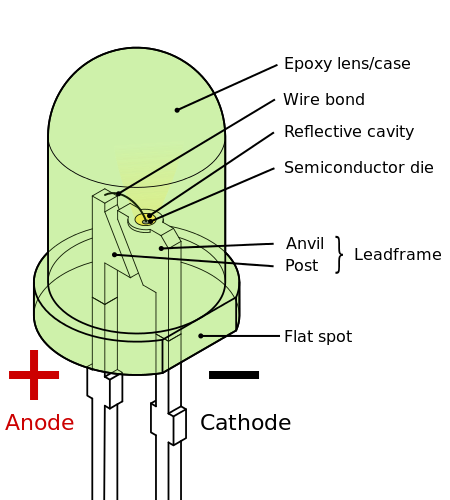| Week 1 | Week 2 | Week 3 | Week 4 | Week 5 | Week 6 | Week 7 | Extension Activity | BBL Tasks | Assessment guidance |
The LED Torch - How an LED works
1 LEDs

Learn It
Light Emitting Diodesare a fairly modern invention. The first practical LED componenets were only developed in 1962, unlike the light bulb which has been around since the late 1800s.- LEDs emit light when a voltage is applied across them. They last a long time, use very little energy and are vey cheap to manufacture. This makes them superior to light bulbs in many applications.
- Despite how much LEDs are used, new types are still being developed.
On October 7, 2014, the Nobel Prize in Physics was awarded to Isamu Akasaki, Hiroshi Amano and Shuji Nakamura for "the invention of efficient blue light-emitting diodes which has enabled bright and energy-saving white light sources" or, less formally, LED lamps.
Research It
- Find out how many different colours of LED there are. Try and find a picture to illustrate this.
Learn It
- Look at the diagram of the LED below

- LEDs can only be placed in a circuit one way round. (You'll learn why in a bit).
- They have one leg that is the cathode and another that is the anode.
- There are several ways to recognise which side of the LED is which.

- Compare this list to the diagram above, so you know what the parts are.
2 Assessment
Badge It- Silver
Progress ladder Red, Identify several electronic components, with assistance.
- Either, find an LED and take a photo of it using your phone or tablet (or your teacher's) or go online and find an image of a real world LED (not a drawing, HINT: Google 'LED Closeup'). Make sure you get a close up.
- Use a graphics package to try and label the photo, like the diagram above.
3 How LEDs work
Learn It
- LEDs contain two different types of material, one that carries positive charges called
holesand one that carries negative charges - the electrons we met in the last lesson. - The holes try to flow from the anode towards the cathode.
- The electrons try to flow from the cathode to the anode.
- This flow of charges means that current is flowing through the LED.
- If an electron and a hole meet each other, they produce a particle of light.
- The animation should show you why LEDs can only be used one way around.
- Try hitting the
polaritybutton to reverse the way the LED is connected. - You should see that the charges are stuck at either end, and therefore no current is flowing, and no light is emitted.
4 Assessment
Badge It - Gold
Progress ladder Yellow, Conduct some relevant research on a project, with assistance.
- The symbol for an LED is shown below.

- In your own words, and using screenshots of the animation above, try and explain why the symbol is drawn in this way.
- Be sure to include the following points:
- What is meant by anode and cathode
- Why there are two arrows pointing away from the LED
- Why the symbol looks like an arrow with a vertical bar in front of it.
- To get your Gold badge you must provide a clear explanation and use correct spelling and grammar.